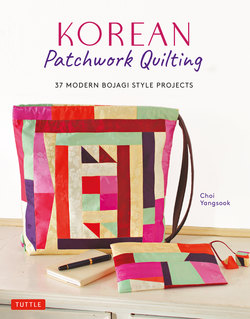Читать книгу Korean Patchwork Quilting - Choi Yangsook - Страница 8
На сайте Литреса книга снята с продажи.
ОглавлениеHOME DECORATIONS
Light and Wind
Bojagi is pieced together from old fabric odds and ends and is infused with blessings of fortune, longevity and good health. Traditionally meant for wrapping and covering, these projects can be certainly used in that way, but they could be beautiful and modern as window coverings or room partitions as well. Happiness is the glow of sunrays filtered through mindfully stitched scraps.
Tapestry
Lightweight silk in hues of pinks, blues and green patched together. When the light hits the finished seam allowances, it casts layers of lovely shadows.
26” x 19½” (66 x 49.5 cm) ❖ Fabric: lightweight silk ❖ Style: Hoppo ❖ Finishing technique: Samsul ❖ Instructions on page 66
Antique Bojagi Replica
Here we’ve replicated a 19th-century square Chogakpo bojagi*. The seam allowances vary in size, and the shadows create an interesting design. This versatile bojagi can be enjoyed and displayed in any direction.
22½” x 22½” (57 x 57 cm) ❖ Fabric: silk (nobang, okusa) ❖ Style: Kyoppo ❖ Finishing technique: Hatsul ❖ Instructions on page 67
*Bojagi’s Simple Elegance by Dong-hwa-hur, published by the Museum of Korean Embroidery. Reproduction of 19th century Chogakpo, page 225.
Chinese Lantern Plants
With the red berry peeking through the gauzy pod, these fabric Chinese lantern plants look like the real deal. Even the seams that connect the fabric pieces perfectly mimic the actual plant.
Approximately 4” x 2” (10 x 5 cm) ❖ Fabric: ramie ❖ Instructions on page 68
Machine-stitched Chogakpo
This machine-stitched Chogakpo has fabric pieces called chikaranuno secured on all four corners. With the help of a sewing machine*, even a larger size that could serve as a curtain can be assembled in relatively little time.
59½” x 59½” (151 x 151 cm) ❖ Fabric: ramie ❖ Style: Hoppo ❖ Finishing technique: Samsul ❖ Instructions on page 69
*Refer to “Using the sewing machine” on page 62 11
Café Curtain
Flowers and leaves formed by the kamon stitching method adorn this bojagi. The thin silk panels flutter in the wind and the diaphanous pale tones diffuse the light beautifully.
35½” x 15¾” (90 x 40 cm) ❖ Fabric: silk (sha) ❖ Style: Hoppo ❖ Finishing technique: Samsul ❖ Instructions on page 70
Sagappo
The piecing method of starting at the center and expanding outward is very similar to American quilting. The simple design with the striking indigo color creates an attractive combination.
22½” x 22½” (58 x 58 cm) ❖ Fabric: ramie ❖ Style: Hoppo ❖ Finishing technique: Samsul ❖ Instructions on page 72
Tapestry
The juxtaposition of the plain fabric with the pastel colors enhances the overall design. The ties are doubled up on the corners for better functionality.
Piecework: 14” x 39½” (35 x 100.5 cm) ❖ Fabric: silk (sha) ❖ Style: Hoppo ❖ Finishing technique: Samsul ❖ Instructions on page 73
Fettepo
The curved seams make a strong statement while the warm tones are soothing and harmonious to the eyes.
14⅜” x 34⅝” (36.5 x 88 cm) ❖ Fabric: silk (okusa) ❖ Style: Kyoppo ❖ Finishing technique: Hatsul ❖ Instructions on page 74
Fettepo—Worn over clothing, this type of bojagi is not only beautiful but also protects clothes from dust as well.
Moshi Chogakpo
The single-layer bojagi made entirely from white linen and/or hemp pieces feels crisp and fresh. The vertical and horizontal straight seams evoke a street map.
Piecework: 37” x 37” (94 x 94 cm) ❖ Fabric: ramie ❖ Style: Hoppo ❖ Finishing technique: Samsul ❖ Instructions on page 76
Moshi Chogakpo
The technique of piecing cutouts together was originally developed to mend holes. It’s an advanced technique, but mastering it will add complexity and depth to your bojagi.
55⅛” x 58¼” (140 x 148 cm) ❖ Fabric: ramie ❖ Style: Hoppo ❖ Finishing technique: Samsul ❖ Instructions on page 77
Moshi Chogakpo
For this distinctively Korean pattern, indigo-dyed sheer ramie transforms into different shades depending on the suffused light.
60” x 58¼” (152 x 148 cm) ❖ Fabric: ramie ❖ Style: Hoppo ❖ Finishing technique: Samsul ❖ Instructions on page 78
The reinforcing corner elements have no real equivalent English term, but for these projects, we will refer to them as “chikaranuno”—a Japanese term meaning “strong cloth,” often associated the juban collar of kimono. In addition to strengthening the corners, they secure the ties, and have an ornamental element as well. They are made in a variety of sizes and shapes. Some are simple squares as seen here and on pages 17 and 25. Other shapes include bats (pages 16, 26), hearts (pages 14, 27), and rounded (page 15). There can be anywhere from one to four ties on a bojagi. The use of the bojagi seemed to dictate the number of ties. For example, bojagi intended for wrapping money and valuables had a single tie. The three empty corners of the bojagi were folded over the item(s) and then the entire parcel was looped with the tie and secured. Grandmothers used bojagi to carry their grandchildren on their backs and women often wore bojagi as aprons; in these cases, there were two ties. Bigger household objects like bedding and blankets required larger bojagi, which typically had four ties.
In modern times, bojagi are rarely created for specific purposes like the ones listed above. However, ties are still attached to the corners because that is simply part of bojagi, but also because it’s useful to do so, particularly for new ways of using bojagi (e.g. curtains).
In a way, the ties seem to connect the present with the past.
